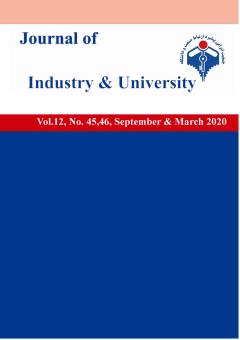Study and comparison of technical and vocational education in Iran with other countries in the world
Subject Areas : General
masoud shafiee
1
![]() ,
Rahim Aminzadeh
2
,
Mahdi Montazarolmahdi
3
,
Rahim Aminzadeh
2
,
Mahdi Montazarolmahdi
3
1 -
2 -
3 -
Keywords: Employment, entrepreneurship, technical and vocational training, skills,
Abstract :
In today's post-industrial world, development in the general sense, regardless of education, especially technical and vocational education, makes no sense, and now, machines do 99% of the work, whereas a hundred years ago, this The figure was only 6%. Therefore, today, the scientific and technical revolution requires skilled manpower. Technology, education and development form the triangle of socio-economic progress. Providing specialized and skilled manpower for the implementation of any program is an impossible necessity, without which material and human investments will be wasted. Economic and social programs have been the lack or shortage of specialized and skilled manpower commensurate with the executive needs of the programs, especially in the middle part of it, of course, the technical university and the vocational training and supply are widely responsible for it. Transformation in the education system of technical and vocational universities, in spite of the numerous goals for which it is intended, finally realizes the filling and filling of the gap of skilled and specialized manpower in the middle part of the labor market with a realistic attitude towards the implementation of development programs in the country. Is. In order to learn the technical, professional and entrepreneurial culture, changes should be made in the educational system and the content of school and university courses, and people who are interested in creating and developing productive activities and the right conditions for the emergence of entrepreneurs should be placed. Provide creative. A comparative study of the higher education system of Iran and countries that have made increasing progress in the development of technical education and professions, shows that by identifying and applying effective educational methods in holding the required and predicted training courses, as well as The comprehensive system of educational evaluation and its content, according to the criteria of job training and the establishment of a regular and up-to-date feedback mechanism, and the modification and improvement of the programs of these vocational schools and colleges, will lead to the growth of creativity and entrepreneurship among graduates of these institutions.
1. امیران، حیدر: آشنایی با نیازمندی های نسخه ی سال2000 استانداردISO9001 ومستندسازی براساس این استاندارد، شرکت مشاورین کیفیت ساز،1381.
2. تسلسمی، محمدحسین: مدیریت کیفیت جامع در آموزش و پرورش، فصلنامه ی مدیریت در آموزش و پرورش، شماره ی21، دوره ی هفتم، انتشارات معاونت برنامه ریزی، 1380.
3. تیشه¬زن، بهمن: نواندیشی در مدیریت آموزش با بهره گیری از مدیریت کیفیت فراگیر.
4. جواهریان، احمد: تضمین کیفیت ، کتاب ماد، تهران، 1378.
5. زمردیان، اصغر: مدیریت کیفیت جامع، اصول، فنون و روش¬های اجرایی، موسسه ی مطالعاتی و برنامه ریزی آموزش گسترش و نوسازی صنایع ایران، 1373.
6. دمینگ، ادوارد: خروج از بحران، ترجمه ی نوروز درداری، انتشارات فرهنگی رسا، چاپ دوم، 1377.
7. سالیس، ادوارد: مدیریت کیفیت فراگیر در آموزش، ترجمه ی علی حقیقی، نشر هوای تازه، تهران،1380 .
8. کزازی، ابوالفضل: مدیریت کنترل کیفیت فراگیر نگرش کاربردی، انتشارات مرکز آموزش مدیریت دولتی
9. موسوی، علی: بهبود سیستم از طریق رویکرد مدیریت تضمین کیفیت در مرکز آموزش فنی وحرفه ای 22بهمن ساری، پایان نامه کارشناسی ارشد، دانشگاه آزاد اسلامی اراک.
10. هوآرن، بریان و دیگران:QFD در خدمات، ترجمه ی محمدرضا عباسی و مهشید یزدان پناه، مرکز آموزش مدیریت دولتی، 1381.
11. آزاد، ابراهیم، (۱۳۸۵) " عوامل موفقیت در نظام های آموزش فنی و حرفه ای" "رشد آموزش شاخه حرفه ای، دوره دوم، شماره ۱ پاییز ۱۳۸۵، ۳۱ -۳۷.
12. تالیف یونسکو، (۱۹۷۳)" آموزش و کارآموزی معلمان فنی و حرفه¬ای" ترجمه اقبال قاسمی پویا دفتر تحقیقات و برنامه¬ریزی معاونت آموزش فنی و حرفه ای و موسسه انتشارات فاطمی، ۱۳۶۹.
13.خلاقی، علی اصغر (۱۳۸۵)،"نقش و اهمیت آموزشهای فنی و حرفه ای در توسعه اقتصادی" رشد آموزش شاخه حرفه¬ای، دوره اول، شماره ۳ بهار ۱۳۸۵، ۱۳-16.
14.عباسی، محمود (۱۳۷۸)،" دلایل عدم تمایل دانش آموزان مستعد نظام جدید بوشهر به ادامه تحصیل در شاخه فنی و حرفای" سال تحصیلی۷۷- ۱۳۷۶ پایاننا مه کارشناسی مشاور شغلی تحصیلی مرکز آموزشعالی فرهنگیان فارس.
15. گـودرزی، منـوچهر (۱۳۷۰)، "عوامـل موثر در جذب هنرجویان پسر به آموزش¬های فنی و حرفه¬ای شهرستان اصفهان از دیدگاه هنرجویان"، پایاننامه کارشناسیارشد دانشکده علوم تربیتی اصفهان.


